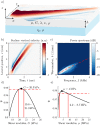Noncontact Acoustic Micro-Tapping Optical Coherence Elastography for Quantification of Corneal Anisotropic Elasticity: In Vivo Rabbit Study
- PMID: 36930138
- PMCID: PMC10036949
- DOI: 10.1167/tvst.12.3.15
Noncontact Acoustic Micro-Tapping Optical Coherence Elastography for Quantification of Corneal Anisotropic Elasticity: In Vivo Rabbit Study
Abstract
Purpose: The purpose of this study was to demonstrate accurate measurement of corneal elastic moduli in vivo with noncontact and noninvasive optical coherence elastography.
Methods: Elastic properties (in-plane Young's modulus, E, and both in-plane, μ, and out-of-plane, G, shear moduli) of rabbit cornea were quantified in vivo using noncontact dynamic acoustic micro-tapping optical coherence elastography (AµT-OCE). The intraocular pressure (IOP)-dependence of measured mechanical properties was explored in extracted whole globes following in vivo measurement. A nearly incompressible transverse isotropic (NITI) model was used to reconstruct moduli from AµT-OCE data. Independently, cornea elastic moduli were also measured ex vivo with traditional, destructive mechanical tests (tensile extensometry and shear rheometry).
Results: Our study demonstrates strong anisotropy of corneal elasticity in rabbits. The in-plane Young's modulus, computed as E = 3μ, was in the range of 20 MPa to 44 MPa, whereas the out-of-plane shear modulus was in the range of 34 kPa to 261 kPa. Both pressure-dependent ex vivo OCE and destructive mechanical tests performed on the same samples within an hour of euthanasia strongly support the results of AµT-OCE measurements.
Conclusions: Noncontact AµT-OCE can noninvasively quantify cornea anisotropic elastic properties in vivo.
Translational relevance: As optical coherence tomography (OCT) is broadly accepted in ophthalmology, these results suggest the potential for rapid translation of AµT-OCE into clinical practice. In addition, AµT-OCE can likely improve diagnostic criteria of ectatic corneal diseases, leading to early diagnosis, reduced complications, customized surgical treatment, and personalized biomechanical models of the eye.
Conflict of interest statement
Disclosure:
Figures





Update of
-
Non-contact acoustic micro-tapping optical coherence elastography for quantification of corneal anisotropic elasticity: in vivo rabbit study.ArXiv [Preprint]. 2023 Jan 25:arXiv:2301.10652v1. ArXiv. 2023. Update in: Transl Vis Sci Technol. 2023 Mar 1;12(3):15. doi: 10.1167/tvst.12.3.15. PMID: 36748003 Free PMC article. Updated. Preprint.
Similar articles
-
Non-contact acoustic micro-tapping optical coherence elastography for quantification of corneal anisotropic elasticity: in vivo rabbit study.ArXiv [Preprint]. 2023 Jan 25:arXiv:2301.10652v1. ArXiv. 2023. Update in: Transl Vis Sci Technol. 2023 Mar 1;12(3):15. doi: 10.1167/tvst.12.3.15. PMID: 36748003 Free PMC article. Updated. Preprint.
-
Acoustic Micro-Tapping Optical Coherence Elastography to Quantify Corneal Collagen Cross-Linking: An Ex Vivo Human Study.Ophthalmol Sci. 2022 Nov 13;3(2):100257. doi: 10.1016/j.xops.2022.100257. eCollection 2023 Jun. Ophthalmol Sci. 2022. PMID: 36685713 Free PMC article.
-
Delineating Corneal Elastic Anisotropy in a Porcine Model Using Noncontact OCT Elastography and Ex Vivo Mechanical Tests.Ophthalmol Sci. 2021 Sep 22;1(4):100058. doi: 10.1016/j.xops.2021.100058. eCollection 2021 Dec. Ophthalmol Sci. 2021. PMID: 36246948 Free PMC article.
-
Anterior segment applications of optical coherence elastography in ophthalmic and vision science: a systematic review of intrinsic measurement techniques and clinical relevance.Prog Biomed Eng (Bristol). 2025 May 15;7(3). doi: 10.1088/2516-1091/add4d9. Prog Biomed Eng (Bristol). 2025. PMID: 40328290
-
Strain and elasticity imaging in compression optical coherence elastography: The two-decade perspective and recent advances.J Biophotonics. 2021 Feb;14(2):e202000257. doi: 10.1002/jbio.202000257. Epub 2020 Nov 3. J Biophotonics. 2021. PMID: 32749033 Review.
Cited by
-
Investigation of mechanical strength and structure of corneal graft-host junction.Heliyon. 2024 May 10;10(10):e30871. doi: 10.1016/j.heliyon.2024.e30871. eCollection 2024 May 30. Heliyon. 2024. PMID: 38784531 Free PMC article.
-
Reconstruction of tensile and shear elastic moduli in anisotropic nearly incompressible media using Rayleigh wave phase and group velocities.J Biomed Opt. 2025 Dec;30(12):124503. doi: 10.1117/1.JBO.30.12.124503. Epub 2025 Aug 5. J Biomed Opt. 2025. PMID: 40787619 Free PMC article.
-
Possible depth-resolved reconstruction of shear moduli in the cornea following collagen crosslinking (CXL) with optical coherence tomography and elastography.ArXiv [Preprint]. 2023 Jun 26:arXiv:2306.15018v1. ArXiv. 2023. Update in: Biomed Opt Express. 2023 Sep 01;14(9):5005-5021. doi: 10.1364/BOE.497970. PMID: 37426451 Free PMC article. Updated. Preprint.
-
Possible depth-resolved reconstruction of shear moduli in the cornea following collagen crosslinking (CXL) with optical coherence tomography and elastography.Biomed Opt Express. 2023 Sep 1;14(9):5005-5021. doi: 10.1364/BOE.497970. eCollection 2023 Sep 1. Biomed Opt Express. 2023. PMID: 37791258 Free PMC article.
-
Simultaneous tensile and shear measurement of the human cornea in vivo using S0- and A0-wave optical coherence elastography.Acta Biomater. 2024 Feb;175:114-122. doi: 10.1016/j.actbio.2023.12.019. Epub 2023 Dec 14. Acta Biomater. 2024. PMID: 38101555 Free PMC article.
References
-
- Hatami-Marbini H. Viscoelastic shear properties of the corneal stroma. J Biomech. 2014; 47: 723–728. - PubMed
-
- Sloan SR, Khalifa YM, Buckley MR. The location- and depth-dependent mechanical response of the human cornea under shear loading. Investig Ophthalmol Vis Sci. 2014; 55: 7919–7924. - PubMed
-
- Zeng Y, Yang J, Huang K, Lee Z, Lee X. A comparison of biomechanical properties between human and porcine cornea. J Biomech. 2001; 34: 533–537. - PubMed
-
- Wollensak G, Spoerl E, Seiler T. Stress-strain measurements of human and porcine corneas after riboflavin-ultraviolet-A-induced cross-linking. J Cataract Refract Surg. 2003; 29: 1780–1785. - PubMed
Publication types
MeSH terms
Grants and funding
LinkOut - more resources
Full Text Sources
Research Materials

